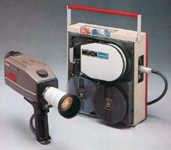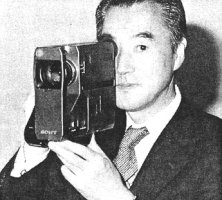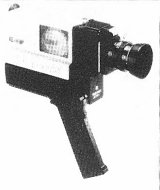A portable VTR and camera

| There are two main parts to a video camera: the lens, which collects the image, and the tube, which converts it into an electronic signal. Both are expensive, delicate, and heavy -- exactly what you don't want in a portable device, particularly if you are trying to market it as a consumer product. | |
| Cameras were available for the reel-to-reel portable VTRs of the 60s, however, and were pretty similar in
size and weight to the cine cameras of the day. They generally used a single tube (rather than the three used by broadcast
cameras, one each for red, green and blue). The quality of these cameras was naturally lower than professional systems,
and this allowed the lenses to be made more cheaply -- though, interestingly, these removable lenses are now the most
valuable part of the surviving cameras from this era.
A portable VTR and camera |
 |
| But however small and light the camera could be made, you still had to lug around a heavy "portable" recorder, with a thick cable connecting it to the camera. The "Holy Grail" of portable video would be a single lightweight unit combining a camera and a recorder in a single machine -- a "camera-recorder", or (as we now call it) a camcorder. | |
| One obvious way to reduce the size and weight was to use a new, smaller cassette format, and several prototype
miniature systems were demonstrated in the early eighties: MagCamera from Hitachi,
MicroVideo from Panasonic and Handy Camera from Sanyo, plus VideoMovie from Sony. The situation was looking all too
familiar, and in 1982 JVC, Matsushita, Sony and Philips got together to try to agree a common standard, based on the
best features of the existing prototypes. This was to be based on 8mm tape (like Sony's VideoMovie), and would be called
Video-8. It was scheduled to be released "after 1985".
A prototype 'VideoMovie' unit from Sony |
 |
 |
While all this was going on, Sony did in fact launch the worlds first camcorder, the
BetaMovie BMC-100 which
went on sale in 1983. Although this used a full-sized Betamax cassette, sony managed to get the weight down using some
extremely lateral thinking. But the compromises made meant that the BMC-100 was almost immediately obsolete, as technology
moved on.
A prototype of the BMC camcorders. Note the cine-camera styling - which survived into the final product. |
|
| In all, 122 companies joined up to the Video-8 project. But in an eerie repeat of the Beta/VHS story, JVC then started to back away from the project - despite being one of the key players in the its inception. | |
| In 1983 they brought out a shoulder frame for their VHS-C equipment, which
allowed a portable VHS-C recorder and camera to be docked together. This put them just one step away from a single
integrated camera/recorder.
Almost a camcorder: the GZ-S5 camera docked to an HR-C3 VCR by its cradle |
 |
| They took this step the next year, with the GR-C1 camcorder.
It was an instant success (unlike the BetaMovie machines) and became a classic - the camcorder that everyone remembers
as the first one they saw.
The final step, which allowed the tiny camcorders we know today, was the development of the CCD - a solid-state chip which replaced the camera's glass tube. CCDs are tiny, cheap, almost indestructable and use a fraction of the power of the older technology; they also don't need time to "warm up", work in much dimmer light, and aren't damaged if the camera is accidentally pointed at the sun! |
|